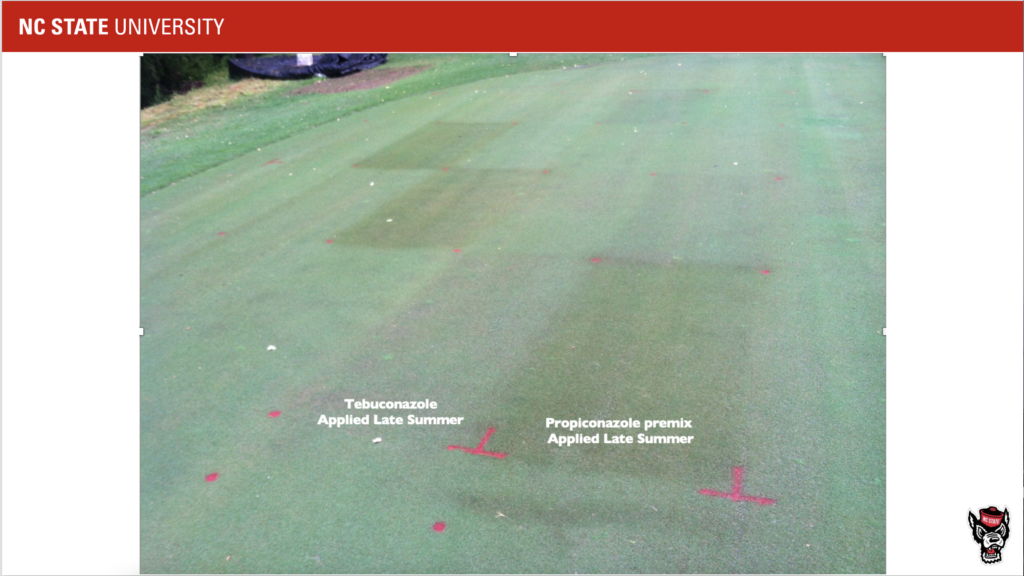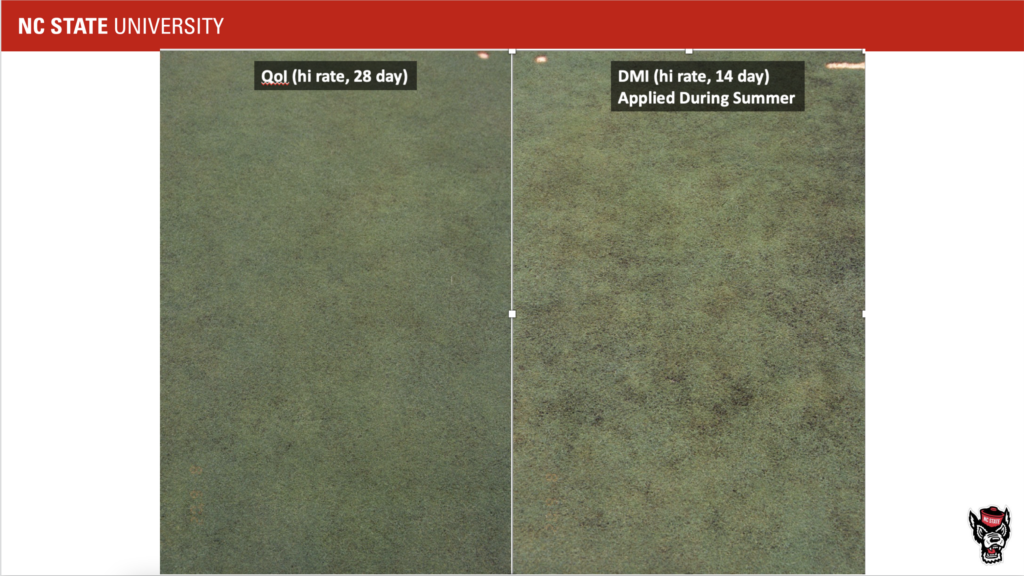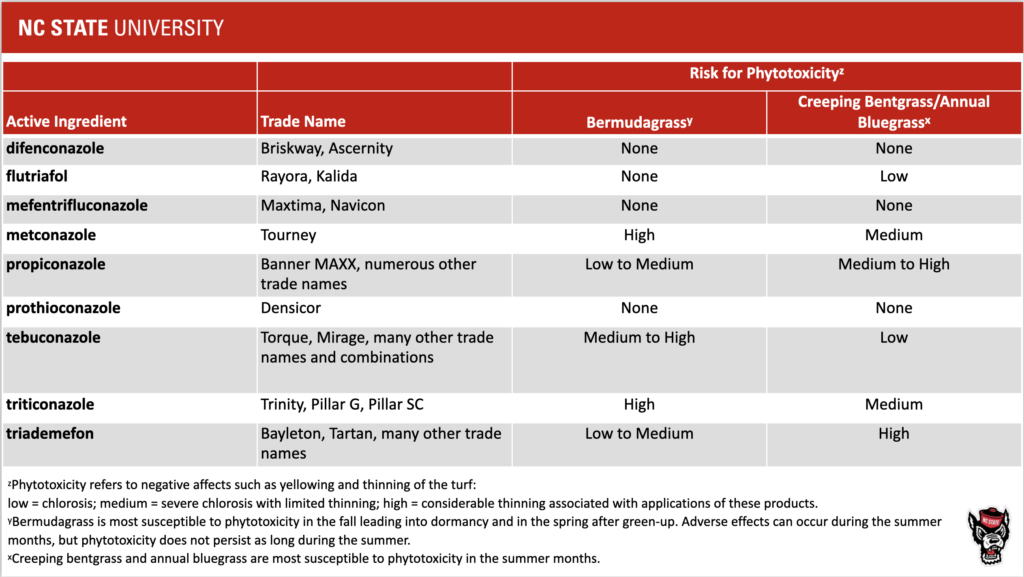Precaution Is Better Than a Cure: Spring Disease Management and Thoughts on DMI Safety
go.ncsu.edu/readext?856968
en Español / em Português
El inglés es el idioma de control de esta página. En la medida en que haya algún conflicto entre la traducción al inglés y la traducción, el inglés prevalece.
Al hacer clic en el enlace de traducción se activa un servicio de traducción gratuito para convertir la página al español. Al igual que con cualquier traducción por Internet, la conversión no es sensible al contexto y puede que no traduzca el texto en su significado original. NC State Extension no garantiza la exactitud del texto traducido. Por favor, tenga en cuenta que algunas aplicaciones y/o servicios pueden no funcionar como se espera cuando se traducen.
Português
Inglês é o idioma de controle desta página. Na medida que haja algum conflito entre o texto original em Inglês e a tradução, o Inglês prevalece.
Ao clicar no link de tradução, um serviço gratuito de tradução será ativado para converter a página para o Português. Como em qualquer tradução pela internet, a conversão não é sensivel ao contexto e pode não ocorrer a tradução para o significado orginal. O serviço de Extensão da Carolina do Norte (NC State Extension) não garante a exatidão do texto traduzido. Por favor, observe que algumas funções ou serviços podem não funcionar como esperado após a tradução.
English
English is the controlling language of this page. To the extent there is any conflict between the English text and the translation, English controls.
Clicking on the translation link activates a free translation service to convert the page to Spanish. As with any Internet translation, the conversion is not context-sensitive and may not translate the text to its original meaning. NC State Extension does not guarantee the accuracy of the translated text. Please note that some applications and/or services may not function as expected when translated.
Collapse ▲Temperatures are warming throughout the Southeast and turf is waking up from a few jabs in the face from mother nature. On March 13th, temperatures dipped well below freezing in many areas and turfgrasses suffered a setback in growth. As such, symptoms of take-all root rot popped up on many golf courses with ultradwarf bermudagrass putting greens. Moreover, tall fescue lawns that were fertilized in late February or early March experienced a little frost bite from that sudden drop in temperatures. Put it this way, the grasses were enjoying the warm air and forgot their coats that evening. The cool-season grasses will likely grow out of the damage that occurred relatively quickly. The bermudagrass putting greens with symptoms of take-all root rot may not recovery as readily.
Of course, hearing that a disease is present on the samples that were submitted is concerning. However, the pathogens that cause TARR are not actively growing at this time. Growth of these fungi resume when soil temperatures elevate above 65oF and only areas around Wilmington are hovering around those temperatures. Everywhere else in NC, soil temperatures are below 65oF. Pathogen growth does start at these temperatures, but infection does not occur until temperatures are above 68oF so fungicides are not necessary right now. However, we are in the window for preventative fairy ring applications, so select a fungicide that provides both preventative fairy ring and also has take-all root rot activity. Although we might find the pathogen on the stolons of ultradwarf bermudagrass, it does not mean the fungus is colonizing new unaffected tissue. Colonization of the affected tissue occurred last fall and the fungus is still present on that affected tissue. How do we know it’s not active? When we receive samples in the late summer or early fall, it is not uncommon to see the take-all root pathogens growing up onto the leaves after incubating the samples overnight. Plus, the colonized stolons and roots emerging from the nodes are brown. In the spring, the pathogen is clearly evident in the tissue yet it does not grow up onto the leaves nor are the stolons severely rotten. Yes, it is there and that is okay. The fungi that cause take all root rot are also referred to as ectotrophic root infecting fungi, which is fancy way of saying their preferred habit is on the surface of below ground plant parts. These fungi are always present even in healthy turf!
No, we cannot gauge how severe the colonization is. No one can! There are no stages of pathogen infection and colonization. All any diagnostic lab can say is the symptoms of the disease match the signs of the pathogen observed in the affected tissue. That’s it! Like Master Yoda said, “do or do not, there is no try”. So, in our case, there is disease or not, there are no stages or values that can be arbitrarily added. More to come on this topic soon, so stay tuned. The key right now is to focus on providing the plant what it needs to grow out of this damage and pick a fungicide that suppresses fairy ring and take-all root rot given we are in the window for preventative fairy ring.
Speaking of spring diseases like fairy ring, we have received a number of questions about the safety of certain DMI fungicides. These fungicides are ideal right now because many of them provide excellent suppression of both fairy ring and take-all root rot, but many still worry about any adverse effects that some of these products may have. Below is a table listing the risk for phytotoxicity on the two major turfgrass species used for putting greens in the Southeast. These rankings are based on our observations in our fungicide efficacy trials and research and may vary as nutrition, plant growth regulation, and other factors vary at each golf course. Do note that we only observe phytotoxicity in our putting green trials.

Injury on a ‘Champion’ bermudagrass nursery green from multiple late summer applications of DMI fungicides. It is important to note that these applications were NOT watered-in.

Injury on an ‘A-1’ creeping bentgrass research green from multiple summer applications of a DMI fungicide. It is important to note that these applications were NOT watered-in. Notice the amount of algae intrusion do to a thinning canopy.
Given that both fairy ring and take-all root rot are soilborne diseases, it is imperative to irrigate any fungicide in with 1/8 inch of water immediately after the application. This is important to ensure the fungicide comes in contact with the pathogens and this practice seems to limit the severity of phytotoxicity as well. For more information on the efficacy of the fungicides listed in this table for fairy ring and take-all root rot please visit the following sites:



